Art Criticism
The Dakar Biennale Returns, Energized by Conversations About African Epistemologies and Colonial Legacies
Takeaways from the opening weekend of Dak’Art, historically an important platform for thinking about Négritude.
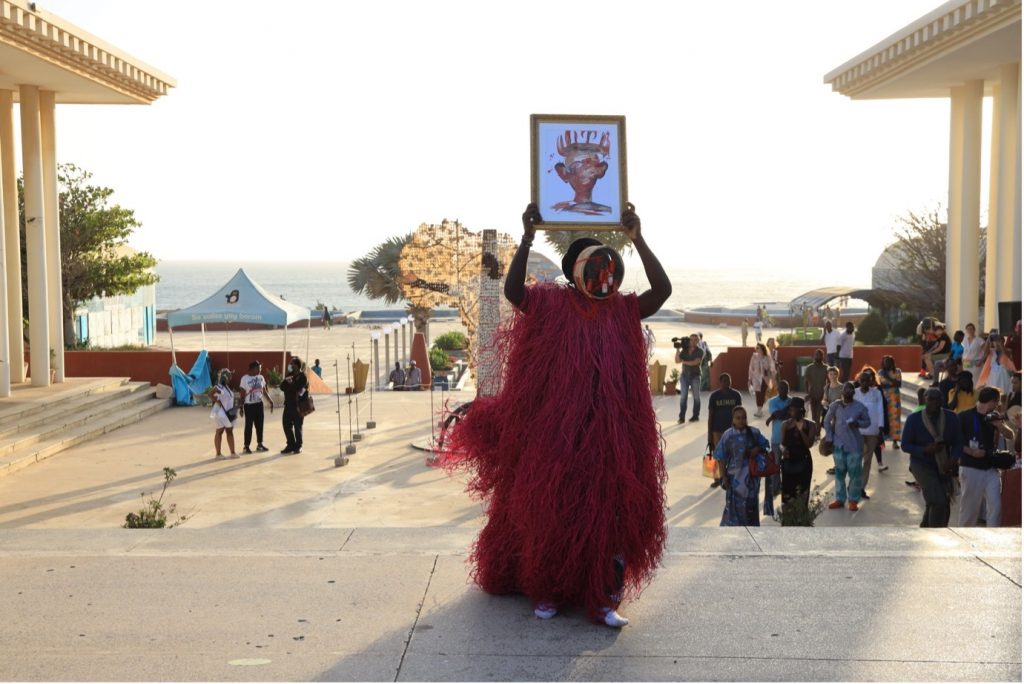
Takeaways from the opening weekend of Dak’Art, historically an important platform for thinking about Négritude.

Tobi Onabolu

As golden hour ushered in one of Senegal’s famous sunsets on the opening weekend of the returned Dakar Biennale, understated elegance made way for euphoria and excitement in the capital known for its spirit of Teraanga, a Wolof word suggesting generosity of character, considered a national virtue.
After a flurry of last-minute bookings in anticipation of the momentous occasion, on Thursday, May 19, stakeholders and onlookers with varied interests in the African art ecology gathered in the former Palais de Justice for the Biennale’s opening for the first time in four years, following a Covid-induced hiatus. With over 400 registered shows in the “LE OFF” program alone—the Biennale’s official satellite events—attendees were somewhat overwhelmed by the volume of shows to see.
Over the years, the Dakar Biennale has established itself as an important axis for fostering critical pan-Africanist thought. This is certainly a legacy of the vision of Négritude, the literary theory birthed by Leopold Senghor, the philosopher, poet, and first president of independent Senegal.
Dak’Art has hence played a significant role in introducing artists to a global audience. Alumni of the event include figures who have gone on to major acclaim such as Abdoulaye Konaté, Emo de Medeiros, Nnenna Okore, Aïda Muluneh, Emeka Ogboh, and Ibrahim Mahama.
Recently, the global art market has experienced an increased appetite for the acquisition of two-dimensional Black bodies, given the trendiness of Black figuration. However, the 2022 Dakar Biennale, titled “Out of the Fire,” had the sense of being immune to fleeting trends and grounded in a retrospective outlook. This, too, is very much in the spirit of Senghor, who once exhorted, “Let us listen to the voices of our Forebears … In the smoky cabin, souls that wish us well are murmuring.”
Endogenous African ways of making were significantly platformed in the main event, as part of a wider narrative of decentralizing approaches to generating both knowledge and wealth. Here, African ways of thinking and storytelling were deliberately reframed, reacting to the historical background in which they have been historically reduced to “less than” fine art, and considered “craft” or “folk art.”
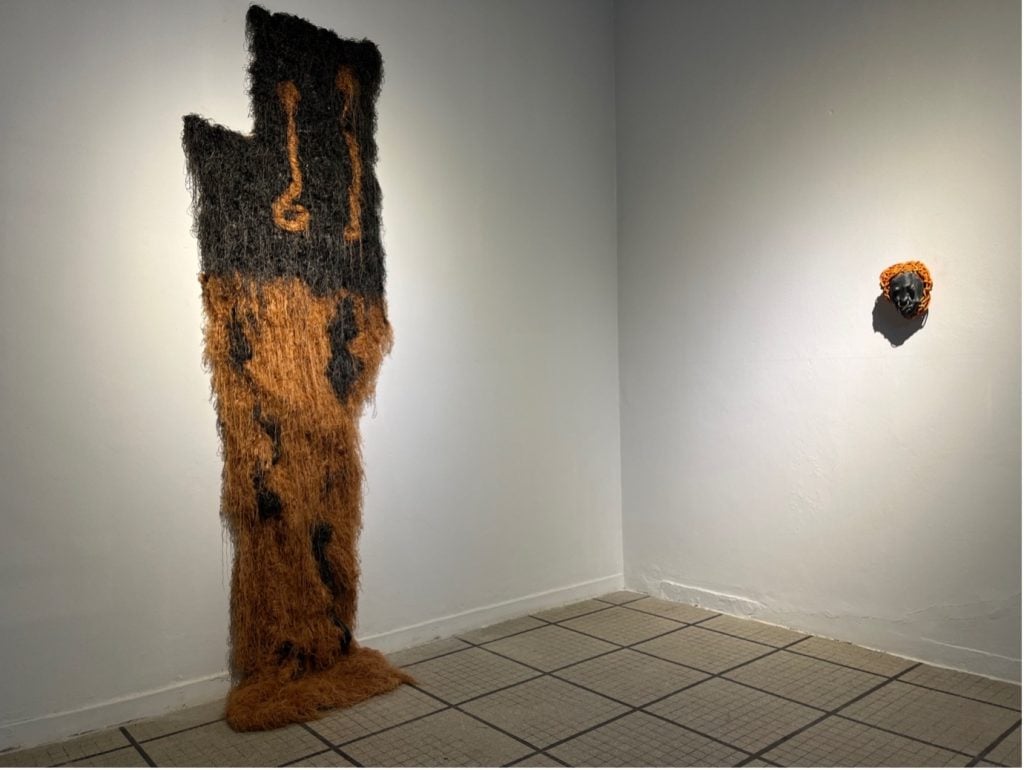
Terence Musekiwa, Vanhu vatema nevhu (Ubuntu and the earth) (2019-2020).
Thus, Terrence Musekiwa’s installation Vanhu vatema nevhu (Ubuntu and the earth) explored space-time theories through his family tradition of stone carving. Connecting with found materials and objects in Zimbabwe, the artist works with stone as a means of communicating and connecting with ancestry. “I have been carving since I was five years old, sat between my father’s legs,” Musekiwa told Artnet News.
For his debut at Dak’Art, Musekiwa incorporated a sculpted stone head and large silk woven piece, hanging over 2 meters high. Through this work, he hopes to spotlight histories of silk weaving in Rhodesia, as a means of recounting the histories of conflict and untold stories that have been part of the story of the tradition. “There is a lot of information in materials,” he explained.
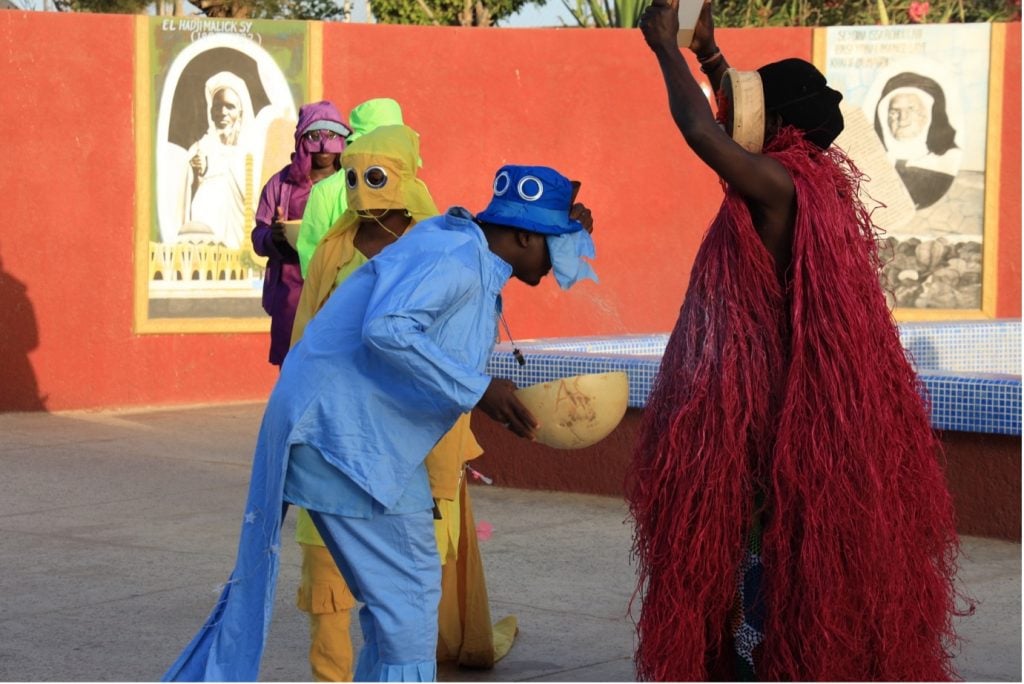
Rafiy Okefolahan, Rendez-nous le Dieu Ogou (Return Orisha Ògún). Image courtesy of Djibril Drame.
Meanwhile, at the Place du Souvenir African (African Remembrance Square), at one of Dak’Art’s orbital events, Yoruba artist Rafiy Okefolahan’s adopted a metaphysical approach to current international conversations around the restitution of looted objects, through installation and performance. With Les couleurs inspirées des spiritueux (Colors inspired by spirituality), Okefolahan presented an abstraction of a shrine as the pretext for a performance piece.
Titled Rendez-nous le Dieu Ogou (Return Orisha Ògún), Okefolahan’s performance referenced the Sculpture Dédiée à Gou (Sculpture dedicated to Ògún), which is currently part of the Quai Branly Museum collection. Draped in bright monochrome outfits, Okefolahan’s collective performed divination practices incorporating cowbells, whistles, and calabashes. The ritual centered raffia as a textile for communicating with divinities, calling the statue back to Benin Republic, transcending more bureaucratic approaches to restitution.
In a three-channel video installation at the main site, Brazilian collective Fluxos do Atlantico extended the subject of African spirituality within Diasporic contexts, interrogating how culture and tradition morph and adapt within new contexts. The Museu Afro Brasileiro in São Paolo is referenced through archival materials as part of a physical installation, questioning notions of return.
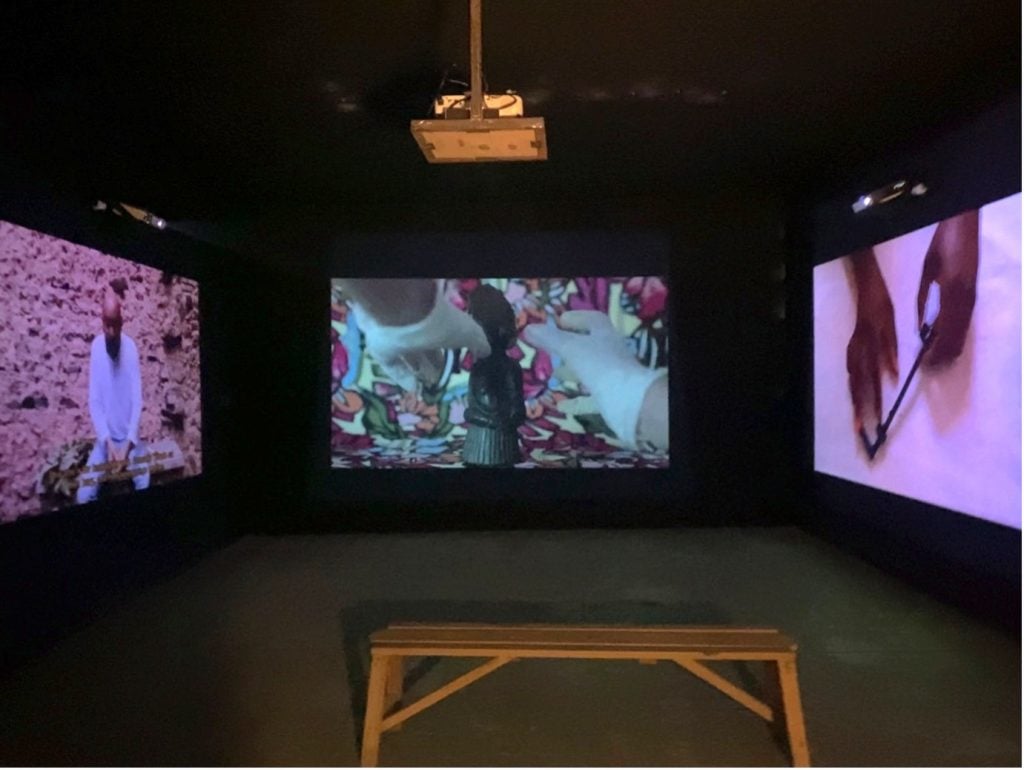
Fluxos do Atlantico, Crossing Archives (2020). Photo by Tobi Onabolu
Elsewhere, at IFAN, a scientific and cultural research institute, Senegalese artist Hamedine Kane reimagined sites of learning through a multimedia installation in collaboration with Stephane Verlet-Bottero. The work consisted of a central building structure, inspired by styles of West African vendors’ shops.
Housing a wide range of objects including rulers, incense, spices, clay pots, combs, and horsetail whisks, Kane’s piece questions the interconnection between spaces and objects in educational environments by bringing together market and school. The installation includes LED-lit mounted chalkboards with subtle explorations of numerology, as well as an expansive bookshelf and floor cushions.
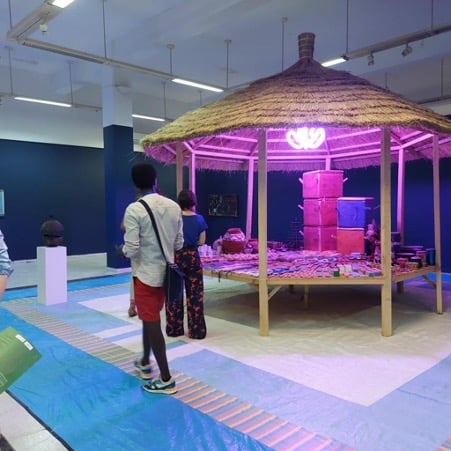
Hamedine Kane, L’école des mutants, Xettu-Xam-Ham. Image courtesy of the artist.
“The pedagogies I aim to convene in this installation come from the educational movement that emerged from the Cheik Anta Diop University, which was created just after independence in the ‘70s by Senghor,” Kane explained. “On Île de Gorée there is also the Mudra Afrique, a dance school [founded in 1977], where Germaine Acogny and Maurice Béjart did all their work on traditional African ballet repertoires, connecting it with contemporary dance.”
Simultaneously to the opening of the Biennale, reflections on publishing were dissected at the African Art Book Fair, an event that invited book makers, writers, and institutions to discourse on defining and writing the canon and its challenges. A panel discussion on artist books and cataloguing led to welcome critical debate around the necessities of publishing, rigorously assessing intentions, functions, and geographical considerations.
Paying homage to the late South African painter Ernest Mancoba, artist and DJ Mo Laudi’s installation at the main Biennale site, Motho ke motho ka batho (A Tribute to Mancoba).
“I wanted to know, who is Mancoba?” Mo Laudi explained to Artnet News, mentioning his importance as “the first Black South African artist to leave the oppressive regime and become a founding member of the COBRA movement.” Recordings of Mancoba’s voice are mixed with original compositions and samples including field recordings and music, Xhosa throat singing, and drumming.
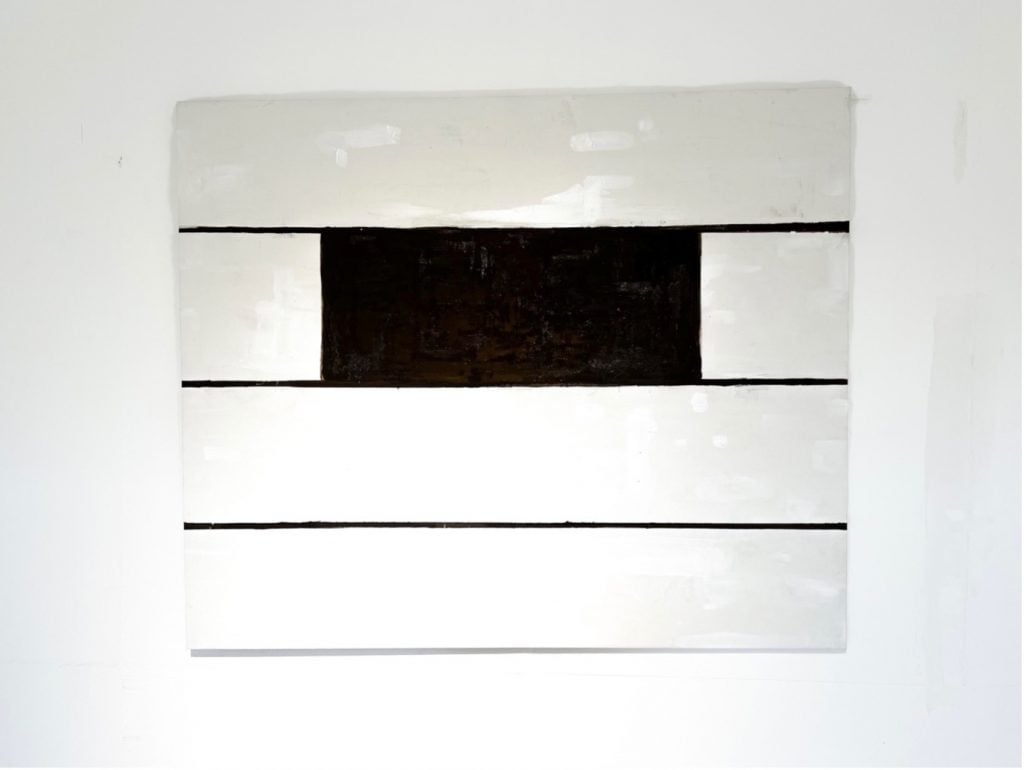
Ntshepe Tsekere Bopape (also known as Mo Laudi), Rest-itution. Image courtesy the artist
In Rest-itution (Série “the rest painting”), Mo Laudi annotates rest on his scores in the classical music tradition, presented through mixed media including Senegalese coffee, clay, acrylic, and charcoal. Mo Laudi says his work considers freedom in the context of ownership and time, inviting an inner stillness and silence: “I play with the notion of rest: rest-itution of the object; rest-itution reclaiming what it means to be an African.”
Drawing on the global Black Radical Tradition from the ‘50 to ‘70s, Mzwandile Buthelezi examines material and color in painting, creating a symbolic language where charcoal signifies percussion, and red pastel invokes the sounds in silence. Movement, rhythm, and improvisation feature prominently in Buthelezi’s works as the artist considers the politics of jazz.
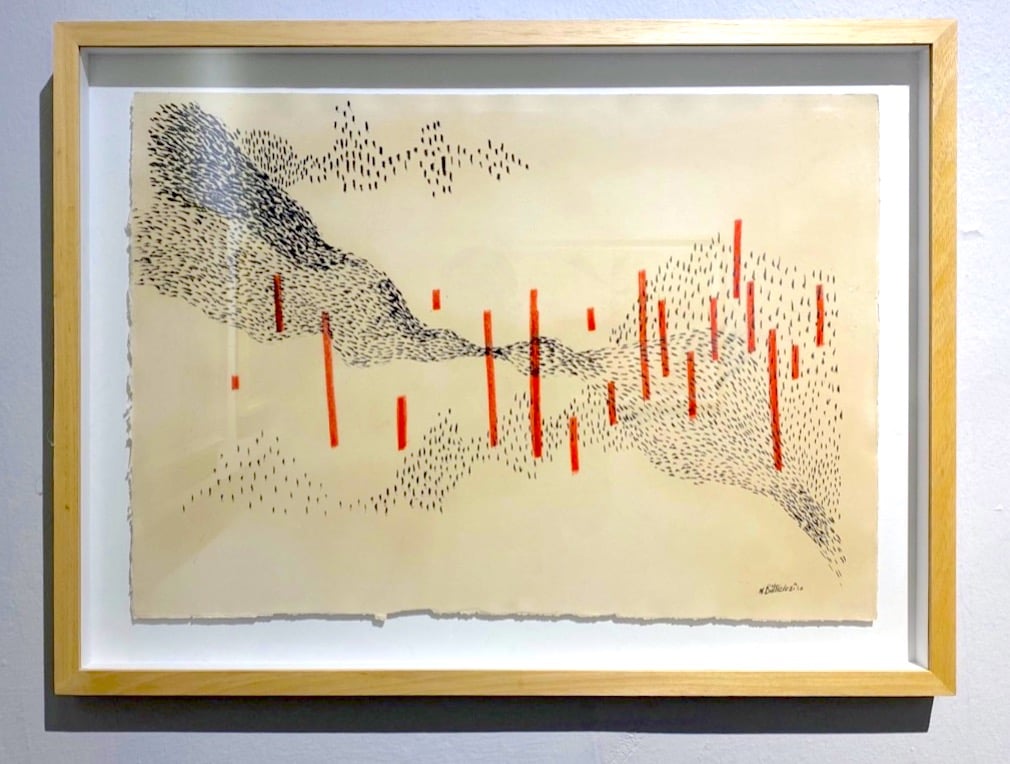
One of Mzwandile Buthelezi’s ‘score-like’ canvasses in the Dakar Biennale. Photo by Tobi Onabolu.
Buthelezi’s musical sensibilities yield “score-like” canvases, offering energized annotations that occasionally take on a three-dimensional quality through the dynamism of their motion. Buthelezi’s works are created with a South Africa-based interdisciplinary collective, Texture of Silence, bridging dialogues between music and visual art, and contributing to conversations on global Blackness.
Even amidst the optimism of the opening of this important Biennale, the recurring paradoxes of the industry linger.
Whilst critical conversations on archiving, literary documentation, and the patriarchy percolate in quiet corners of the city, glamorous parties hosted by European and American institutions continue to hold a disproportionate amount of the industry’s attention—and perhaps you could even say this too is a hangover of Senghor’s complicated legacy. “The equilibrium you admire in me is an unstable one, difficult to maintain,” Senghor once said. “My inner life was split early between the call of the Ancestors and the call of Europe, between the exigencies of black-African culture and those of modern life.”
Nonetheless, the pan-African cultural re-awakening continues to rumble and has received a major boost from the return of the Dakar Biennale. African artists are at the forefront of the movement, doing the researching, thinking, and, ultimately, the work.
“Out of the Fire: The 14th Dakar Biennale” is on view at venues throughout Dakar, through June 21, 2022.